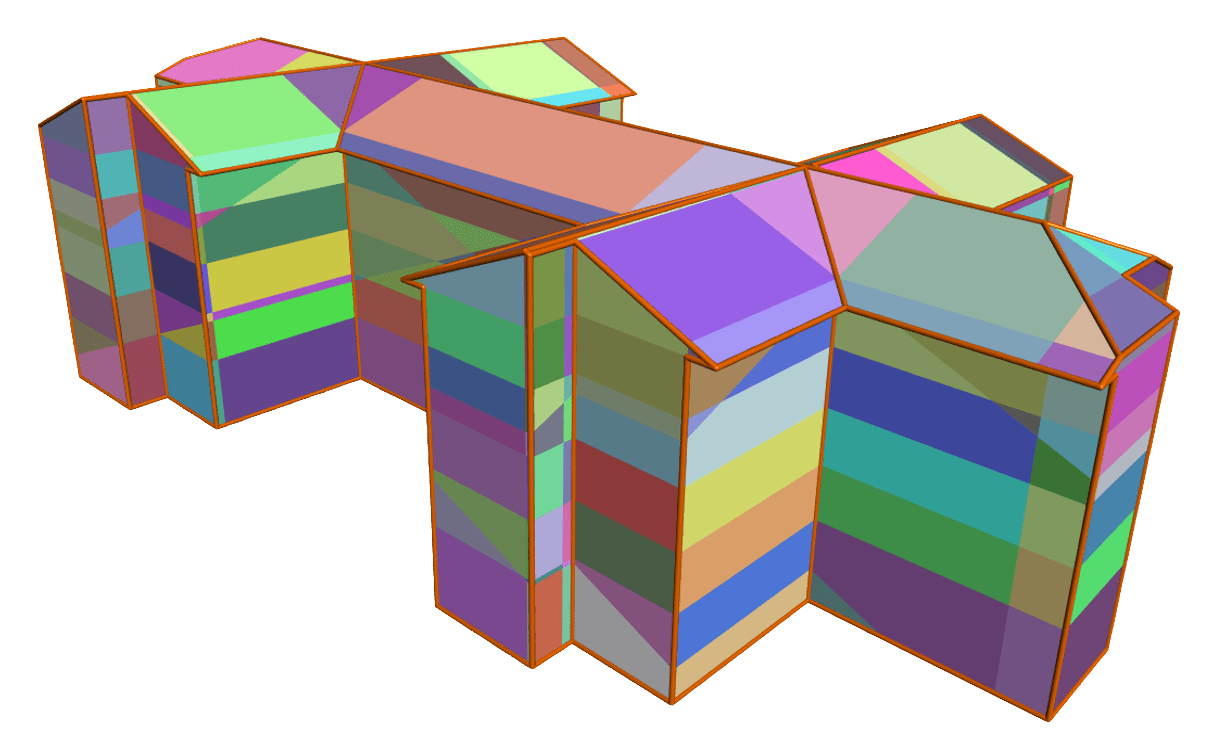Downloads
DOI:
https://doi.org/10.47982/jfde.2022.powerskin.8Keywords:
retrofitting potential, LCA, point cloud, semantic enrichmentAbstract
To meet the climate goals of the Paris agreement, the focus on energy efficiency needs to be shifted to increase the retrofitting rate of the existing building stock. Due to the lack of usable information on the existing building stock, reasoning about the retrofitting potential in early design stages is difficult. Therefore, deconstructing and building new is often regarded as the more reliable and economical option. Digital methods are missing or not robust enough to capture and reconstruct digital models of existing buildings efficiently and automatically derive reliable decision-support about whether demolition and new construction or retrofitting of existing buildings is more suitable. This paper proposes a robust, automated method for calculating existing buildings' life cycle assessments (LCA) using point clouds as input data. The main focus lies in bridging the gap between point clouds and importing semantic 3D models for LCA calculation. Therefore, the automation steps include a geometric transformation from point cloud to 3D surface model, followed by a semantic classification of the surfaces to thermal layers and their materials by assuming the surface elements by building age class.
How to Cite
Published
Issue
Section
License
Copyright (c) 2022 Edina Selimovic, Florian Noichl, Kasimir Forth, André Borrmann

This work is licensed under a Creative Commons Attribution 4.0 International License.
Authors or their institutions retain copyright to their publications without restrictions.
References
Akbarieh, A., Jayasinghe, L. B., Waldmann, D., & Teferle, F. N. (2020). BIM-Based End-of-Lifecycle Decision Making and Digital Deconstruction: Literature Review. Sustainability, 12(7), 2670. https://doi.org/10.3390/su12072670
BBSR, & BBR (2019). Ökobilanzierung und BIM im Nachhaltigen Bauen [Life Cycle Assessment and BIM in Sustainable Construction]. Retrieved from https://www.bbsr.bund.de/BBSR/DE/forschung/programme/zb/Auftragsforschung/2NachhaltigesBauenBauqualitaet/2019/oekobilanz-bim/01-start.html
BBSR, Ö. (2022, May 20). ÖKOBAUDAT. Retrieved from https://www.oekobaudat.de/en.html
BMUB (2017). Bewertungssystem Nachhaltiges Bauen (BNB). Büro- und Verwatungsgebäude. Modul Komplettmodernisierung. BNB_BK 1.1.1: Ökologische Qualität. Wirkungen auf die globale und lokale Umwelt. Treibhausgaspotential (GWP) [Sustainable Building Rating System (BNB). Office and administration buildings. Module whole-building modernization. BNB_BK 1.1.1: Environmental quality. Effects on the global and local environment. Greenhouse gas potential (GWP)]. Retrieved from https://www.bnb-nachhaltigesbauen.de/bewertungssystem/buerogebaeude/steckbriefe-bnb-bk-2017/
Borrmann, A. (2015). Building Information Modeling: Technologische Grundlagen und Industrielle Praxis [Building Information Modeling: Technological Basics and Industrial Practice]. VDI-Buch Ser. Wiesbaden: Springer Fachmedien Wiesbaden GmbH. Retrieved from https://ebookcentral.proquest.com/lib/kxp/detail.action?docID=3567925
CAALA (2020, August 3). Ihr digitaler Assistent für ganzheitliches Entwerfen. – CAALA [Your digital assistant for holistic design. – CAALA]. Retrieved from https://caala.de/
Chen, Z. (2021). Learning to Reconstruct Compact Building Models from Point Clouds (Master Thesis). Delft University of Technology. Retrieved from https://repository.tudelft.nl/islandora/object/uuid:e33e7fa1-118e-41d8-904f-5f03eb36e887?collection=education
CloudCompare (2022). CloudComapre (Version 2.12.1) [Computer software]. CloudCompare: CloudCompare. Retrieved from http://www.cloudcompare.org/
Coughlan, J. M., & Yuille, A. L. (2000). The Manhattan World Assumption: Regularities in scene statistics which enable Bayesian inference.
Dawson-Haggerty et al. (2019). Trimesh (Version 3.2.0) [Computer software]. Retrieved from https://trimsh.org/
Abbrucharbeiten: Grundlagen, Vorbereitung, Durchführung [Demolition work: Fundamentals, preparation, execution]. (2., aktualisierte und erw. Aufl.) (2007). Köln: R. Müller.
Fileformat.info (2022, May 11). Wavefront OBJ: Summary from the Encyclopedia of Graphics File Formats. Retrieved from https://www.fileformat.info/format/wavefrontobj/egff.htm
Ge, X. J., Livesey, P., Wang, J., Huang, S., He, X., & Zhang, C. (2017). Deconstruction waste management through 3d reconstruction and bim: A case study. Visualization in Engineering, 5(1), 1–15. https://doi.org/10.1186/s40327-017-0050-5
Hollberg, A., Lichtenheld, T., Klüber, N., & Ruth, J. (2018). Parametric real-time energy analysis in early design stages: A method for residential buildings in Germany. Energy, Ecology and Environment, 3(1), 13–23. https://doi.org/10.1007/s40974-017-0056-9
Kazhdan, M., & Hoppe, H. (2013). Screened poisson surface reconstruction. ACM Transactions on Graphics, 32(3), 1–13. https://doi.org/10.1145/2487228.2487237
Li, M., Wonka, P., & Nan, L. (2016). Manhattan-World Urban Reconstruction from Point Clouds. In (pp. 54–69). Springer, Cham. https://doi.org/10.1007/978-3-319-46493-0_4
Loga, T., Diefenbach, N., & Born, R. (2015). Deutsche Gebäudetypologie: Beispielhafte Maßnahmen zur Verbesserung der Energieeffizienz von typischen Wohngebäuden [German building typology: Exemplary measures for improving the energy efficiency of typical residential buildings]. Darmstadt.
Macher, H., Roy, L., & Landes, T. (2021). Automation of windows detection from geometric and radiometric information of point clouds in a scan-to-BIM process. The International Archives of the Photogrammetry, Remote Sensing and Spatial Information Sciences, XLIII-B2-2021, 193–200. https://doi.org/10.5194/isprs-archives-XLIII-B2-2021-193-2021
Matthias Hüttmann (2018). Graue Energie Abreißen oder sanieren? [Demolishing or retrofitting embodied energy?] BUND-Jahrbuch 2018 Ökologisch Bauen Und Renovieren: Nachhaltige Orientierung für Bauherren, 16–19. Retrieved from chrome-extension://efaidnbmnnnibpcajpcglclefindmkaj/viewer.html?pdfurl=https%3A%2F%2Fwww.bund-bawue.de%2Ffileadmin%2Fbawue%2FDokumente%2FThemen%2FKlima_und_Energie%2FOEkologisch_Bauen_und_Renovieren_2018_Graue_Energie._Abreissen_oder_sanieren.pdf&clen=913329&chunk=true
MERKO (2022, May 11). DEMO DATA | Drupal. Retrieved from http://www.merko.lv/en/demo-data
Nan, L., & Wonka, P. (2017). PolyFit: Polygonal Surface Reconstruction from Point Clouds. https://doi.org/10.1109/ICCV.2017.258
Park, J., & Cho, Y. K. (Eds.) (2021). Laser Intensity-assisted Construction Material Classification in Point Cloud Data using Deep Learning. Orlando, FL.
Schnabel, R., Wahl, R., & Klein, R. (2007). Efficient RANSAC for Point-Cloud Shape Detection. Computer Graphics Forum, 26(2), 214–226. https://doi.org/10.1111/j.1467-8659.2007.01016.x
Schneider, S., & Coors, V. (2018). Automatische Extraktion von Fenstern in 3D Punktwolkenmittels einer hierarchischen Methode [Automatic extraction of windows in 3D point clouds using a hierarchical method] (38. Wissenschaftlich-Technische Jahrestagung der DGPF und PFGK18 Tagung in München No. 27). München. Retrieved from https://www.researchgate.net/publication/323749844_Automatische_Extraktion_von_Fenstern_in_3D_Punktwolken_mittels_einer_hierarchischen_Methode
Taraben, J., & Kraemer, K. (2021). Automatisierte Generierung von Stadtmodellen aus UAS-Befliegungen für die energetische Bewertung von Quartieren [Automated generation of city models from UAS flights for the energetic evaluation of neighborhoods] (32. Forum Bauinformatik 2021).
Umweltbundesamt (2021, November 29). Abfallaufkommen [Volume of Waste]. Retrieved from https://www.umweltbundesamt.de/daten/ressourcen-abfall/abfallaufkommen#bau-abbruch-gewerbe-und-bergbauabfalle
Volk, R., Luu, T. H., Mueller-Roemer, J. S., Sevilmis, N., & Schultmann, F. (2018). Deconstruction project planning of existing buildings based on automated acquisition and reconstruction of building information. Automation in Construction, 91, 226–245. https://doi.org/10.1016/j.autcon.2018.03.017
Yang, J., Shi, Z.‑K., & Wu, Z.‑Y. (2016). Towards automatic generation of as-built BIM: 3D building facade modeling and material recognition from images. International Journal of Automation and Computing, 13(4), 338–349. https://doi.org/10.1007/s11633-016-0965-7
